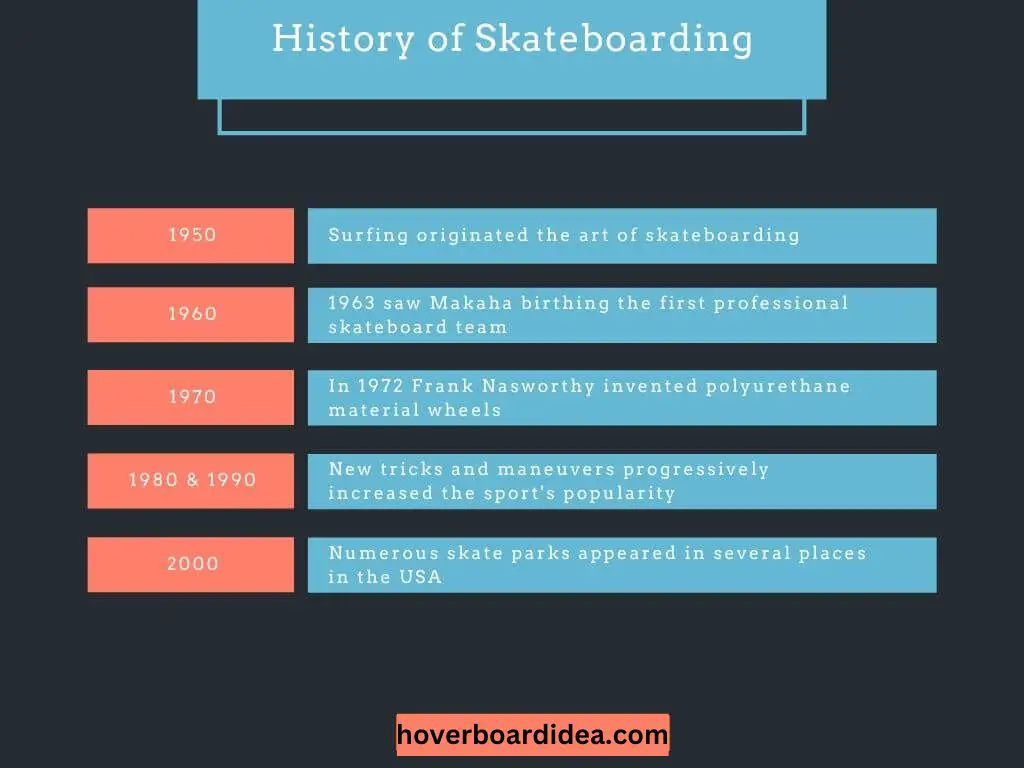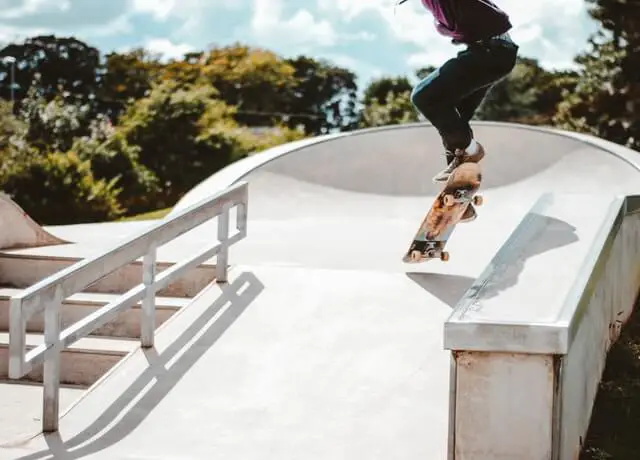Skateboarding is an art that involves riding and performing tricks using a skateboard. It is a sporting and recreational activity. And if you didn’t know, some people skateboard as a means of transporting themselves from one point to another.
How did Skateboarding start?
The concept of skateboarding started as a way of surfing on earth. Californians wanted something to surf on while the waves were flat, and since you cannot surf on concrete surfaces, they invented a “Board with Wheels.”
History of Skateboarding
The 1950s’
Surfing originated the art of skateboarding. There are two focal points of skateboarding’s history: Hawaii and California. Californians desired a way of surfing whenever ocean waves became flat. This desire led to the development of boards with Wheels.
Various inventions spontaneously erupted in the mid and early ’50s. However, the first skateboard’s origin is not accurately known. Initially, there were wooden boards with roller skater wheels and later short surfboards with metallic wheels without bearings.
In the late 1950s, the skateboarding game reached its first peak as toy industries like Roller Derby became aware of the skateboards. In 1959, Roller Derby produced the first commercial skateboard with the following advantages;
- They had improved handling characteristics.
- They possessed the ability to perform maneuvers and tricks.

The 1960s
1963 saw Makaha birthing the first professional skateboard team. That same year the first skateboarding competition took place in Hermosa Beach, California. Skateboarders demonstrated their prowess in styles like freestyle and slalom. The same year also saw companies like Hobie begin to sponsor riders.
Hobie Super Surfer Skateboard Team won the International Skateboarding Championship as published in 1964 Skateboarder Magazine, and attributed their stunning performance to the exclusivity of their skateboard trucks, which had:
- 5/16″axle,
- double action cushion for absorbing shock, and
- Wheels designed for gripping concrete and asphalt surfaces.
Skateboarding continued to gain popularity, leading to the first skateboarding magazine, “The Quarterly Skateboarder,” published in 1964. According to Skateboarder Magazine, tourists from the USA had introduced skateboarding even as far as France, winter 1964.
In 1965 some safety experts considered the game unsafe and discouraged the hobbyists and sportspersons from it. Individuals came up with homemade clay wheels boards since the manufacture of commercial production came to a stop.
The 1970s
In 1972 Frank Nasworthy invented polyurethane material wheels, which revived skateboarding, and the invention of “kicktail” by Larry Stevenson made it easier to ride skateboards. The new material made riding;
- Smoother,
- Faster and more comfortable.
In 1975, skateboarding took a different direction. In Del Mar, California, Skateboarders held a slalom and freestyle contest at the Ocean Festival.
The skateboard magazines promoted the sport and young creative riders such as Tony Alva and Stacey Peralta.
Construction companies later created skate parks in 1976. These parks had vertical ramps and kickers that allowed vertical jumps and rolls. In Munich, Neuperlach, Germans built the first skate park.
The first skateboard magazines in German came into existence, and the first German Skateboard Championships took place in 1978.
In 1978, Alan Gelfand gifted the world of skateboarding a trick called the Ollie. This maneuver further revolutionized the game and birthed street skateboarding. It involves slamming a foot down on the kicktail while sliding the front foot forward, causing both the skater and the board to jump.
1980s & 1990s
New tricks and maneuvers progressively increased the sport’s popularity as Skateboarders became more famous, just like baseball and football stars.
Skateboarders passionate about the sport started building their skate parks in their backyards. They also took to the streets with their game. Development of various boards took place in this period. More manufacturers strived to improve the maneuverability and stability of their products.
The stylistic maneuvers and new tricks saw the first skate video appear on VHS. The Bones Brigade Video Show started televising the game for children worldwide.
By the end of 1980, street skateboarding was overtaking vertical skateboarding. In the mid-1990s’ it experienced a high phase change that continued to progress until today. Mega-events like the “X-Games” held in Spain in 1995 began, and televisions started broadcasting them.
The 2000s & Now
Numerous skate parks appeared in several places in the USA. The trend spread all through South America and other parts of the world. Skateboarding video games starting being popular and allowed ardent kids to practice skateboarding.
The ill notion that skateboarders were criminals began to diminish as the skateboarding X-Games become popular. According to “Thrasher” magazine, skateboarding has taken new heights with the T -Eddy Awards 2020 in place and other promotions.
Street league contest for international pro skateboarders has become a worldwide known event, with a big prize to win. The Street League is a place for the best street skaters like Eric Koston, Torey Pudwill, Nyjah Huston, Ryan Sheckler, and Andrew Reynolds.

The First Skateboarding Competition
The first skateboarding competition took place in Hermosa Beach, California, in 1963. It was organized by companies such as Hobie. Here, skateboarders showcased their skills in slalom or freestyle and tricks.
The Best Skateboarder Ever
Rodney Mullen is considered to be a skateboarding legend. He started skateboarding at the age of ten after his friends introduced him to a Board with Wheels. Skateboarding fans consider Rodney Mullen to have invented skateboarding as a sport.
He was considered a unique skateboarder, having invented some skateboarding ollies and flip tricks. They include backside flip, 360 flip, one-footed ollie, and other tricks that are the basis of today’s street skateboarding. Rodney Muller is undoubtedly the best skateboarder ever.
Final Verdict
Although records on how skateboarding started are somewhat inconclusive, we notice that the idea cropped up first in California. It later spread rapidly to other states, thanks to enthusiastic skateboarders. The commercial manufacturing of skateboards led to the game spreading like wildfire.
The evolution of skateboarding later took its course spearheaded by skillful inventive skateboarders like Rodney Muller, Bob Burnquist, Tony Hawk, Alan Gelfand, Tony Alva, Stacey Peralta, Danny Bearer, and Nyjah Huston, and others.
Skateboarding has now evolved into an internationally recognized sport and increased its legitimacy among numerous skaters worldwide.

